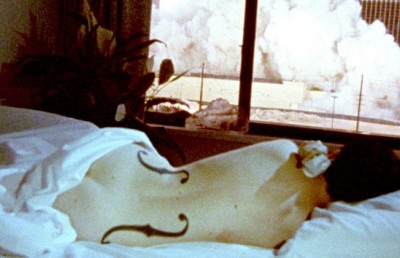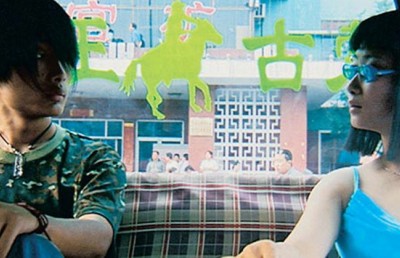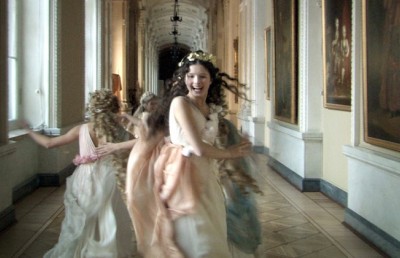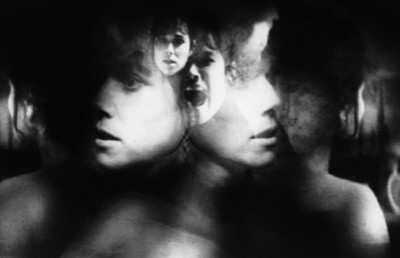An Interview with Peter Mettler
Peter Mettler at the International Festival of New Cinema and New Media
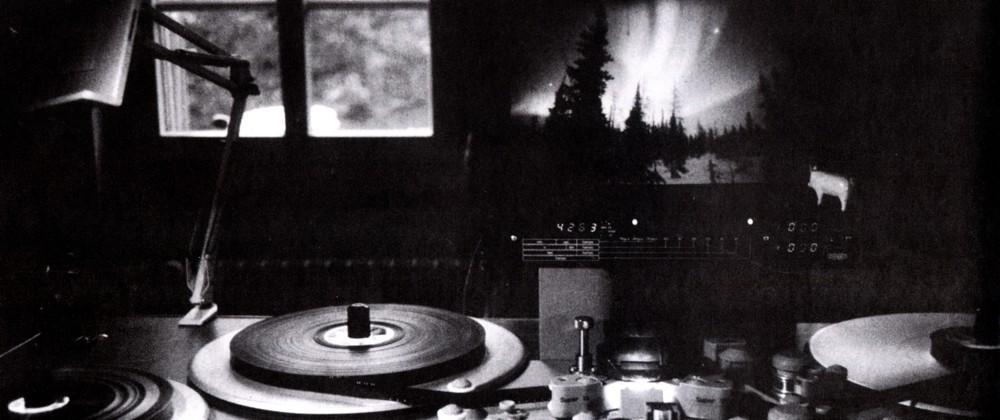
I met Peter Mettler at the Ex-Centris cinema complex in Montreal on the 14th of October, 2002, during the International Festival of New Cinema and New Media. I had just taken in a screening of Michael Snow’s Corpus Callosum and was excited to see several Canadian films including Ararat, Atom Egoyan’s latest, and Gambling, Gods and LSD, arguably Mettler’s finest work to date. The diversity in Canadian films was perhaps slightly too esoteric in terms of its varying target audiences, but acknowledged Canadian talent on the map of contemporary art cinema. Peter was exactly how I had perceived him to be, given his understated appearance and the soothing, calm quality of his voice, overheard as narrator for several of his films. He was anxious to talk about the new film, given that the Festival screening was a North American premiere, and he had recently come out of a long, strenuous but rewarding process that had the film transform from its initial fifty-five hour length to a much more sustainable three hour duration. Mettler is an introspective person, equally interested in how we, as viewers, perceive films as in how he, as filmmaker, makes them. We discussed GGLSD, upcoming projects and the future of the cinematic medium itself over a couple of cups of coffee and pack of cigarettes.
Offscreen: How might the earlier work of Atom Egoyan (with which Peter Mettler was a collaborator, performing as Egoyan’s cinematographer on several early films) have had an influence on your particular style or your career in general?
Peter Mettler: I was never really a Director of Photography and I never wanted to be one. I was studying at Ryerson and at the time I met Atom I was finishing Scissere (1982). He was at University of Toronto making short films, while studying political science. He was looking for someone to work with, came to Ryerson, saw Scissere and really liked it. We started talking and he asked me to shoot for him. And it was a really interesting exchange, because he had very little experience with film language per se; he was coming from a theatrical, historical and literary background and I was coming from a much more sensorial domain, so we actually merged quite well. It (my relationship to Atom) was and still is a friendship and we’re always exchanging ideas, but I think we work very differently. We both admire what the other does, but we do different things. We can relate to each other and we talk about that in terms of how a piece is built, how its structured, what the character of the camera is, or how the vision is presented. He gave me more of an appreciation of script ideas, or structural and plot ideas while I think I offered him a sensorial or visual approach; how to tell a story visually.
Offscreen: There seems to be something about the narrative of Top of his Head (1989) which resembles the structure of some of Egoyan’s work around the same period, i.e. The Adjuster (1991), or Exotica (1994). Did those works have an effect on you and could you understand their mood and visual style in terms of a significant evolution in Canadian cinema?
PM: I think the similarities are due to a climate, working in the same city at the same time. If anything I would try not to be like him (laughs). I was seeing the whole satellite/communications/technology idea on a metaphorical level, which is not the way he uses technology. He uses technology more to tell stories or to give layers to the narrative. But we were both aware of changing technology & what the presence of video was doing to our consciousness and our environment as well as how it was affecting cinematic language. Other people were doing similar things but Atom became one of the first to employ the video medium (i.e. Family Viewing [1986] in which case segments are shot like a TV show). Here, the video language suddenly entered the art mainstream and became a topic. With films like Sex Lies and Videotape (1989), as soon as the medium of technology took a leap everybody started exploring it in their own ways. Digital Video is now being used in a multitude of ways as well, which changes the language; changes the perception; changes the communication; and changes the meaning of what that language is. It brings new expression to the cinema medium. We’re interested in how video informs our perception; also if you could equate it to a consciousness i.e. what is a video consciousness vis-à-vis a film consciousness. And Atom and I worked together recently rendering Krapps Last Tape (2001), a play by Samuel Beckett, performed by John Hurt. We shot in Ireland in four days, combining all our energies and interests, employing twenty minute long takes. It’s a play about audio recording in which Krapp is listening to tapes he has recorded throughout his life and reflects on them. And us filming added an additional layer to the recording process. The camera had a kind of consciousness that was perceiving, as the visual recording was crowding him or moving in on him in the same way that the audio tapes were crowding his reflection. A kind of explosion onto another level of recording.
Offscreen: What do you dislike about the contemporary cinematic experience and how would you like to see works that involve cinematic properties and traditional cinema/spectator relationships improved upon?
PM: I’m quite interested in abandoning the formal situation of a cinema in which people pay to go in, sit down, watch a bit of advertising, buy some popcorn, see a film and exit. I’m a lot more interested in interaction or seeing a film but not leaving, while remaining and developing the evening into either a discussion or a party or another level, so that there’s also a sense of community there. I’m interested in different situations, or sights and ways of presenting different cinematic experiences. And the rave scene, of course, is a big one because the ravers are often under the influence of drugs, which is like a medium in itself. It gives you a unique vision, or certain perception, combined with music and dancing, although the visual stimulation is lucid and clear and you’re engaged in it through a more three dimensional cinematic experience.
Offscreen: As far as the drug references are concerned, which appear in GGLSD as well as in Scissere (1982), what is it about the drug state which you find so interesting, that we obviously encounter in your films?
PM: Lots of things, as I proposed, it’s like a medium in itself. And as a medium it is also similar to the unconscious or (depending on the drug) it lets the unconscious surface with a logic of its own i.e. a dream state. In a simplistic way, you can see how the drug state functions organically or chaotically because it breaks down our ability to structure things intellectually in references that we are familiar with. It cracks a lot of our patterns of thinking, which are all things I like to do in cinema, that intrigue me. In terms of the thematics of Gambling, Gods and LSD, in referencing Roger (half of the couple from the Switzerland segment), a different drug can take you to a place that is very peaceful, whereas if you meditated, it may take you ten years to achieve a like state of mind. But while many of these drugs place man in great danger all these drugs can be abused so quickly and many are addictive and ultimately give a flash perspective on something. If abused, one can lose touch of a functional base of reality.
It is an intense experience like many others, not unlike a car accident, which will hopefully teach you something in the end. That’s why it was quite difficult (in the film) to find the right balance of how to present the two drug users in Switzerland, because I wanted to present them as people, not as junkies—people who use drugs. One of Christine’s last lines in the Switzerland episode was that the drug experience was enticing, beautiful, and it absolved her need to search, but at the same time it took her into a place of horror and terror. And while she had the good fortune of getting out of it, her last statement is that it was a very valuable experience. She’s glad she went through it because it took her further in the end. She was lucky because this doesn’t usually happen to most heroin abusers. And I don’t want to end up promoting the use of heroin by saying that. Albert Hofmann (the scientist from the same episode) talks about experience too, and how every experience changes you and the more profound the experience the more there is to learn from it.
Offscreen: Right from its inception, the film throws the viewer into a world that is narratively as well as visually ambiguous. What are some of the choices, or lack of choices, that enable or force your treatment of the material as it evolves before you in creating the unique Peter Mettler experience?
PM: Never in the film was I really trying to evoke anything. Contrary to a film such as Top of His Head (1989), where I am deliberately and consciously styling, choosing and designing, GGLSD was the opposite. I was going to meet people or see things that relate to the ideas that I’m exploring and just deal with it as it comes. And it would have its own look and its own character by virtue of the situation. I met John Paul Young (the cigar smoker in opening segment) after a church gathering that he was at and he suggested we go for a walk. I asked to place a microphone on him, and those were the conditions. I had no idea what was going to happen on that walk. Most of the film operates in a similar way. And in the editing, you make choices about (mostly) what to leave out because it was a 55 hour assembly with all the ingredients in it. It was a question of structuring, all the while maintaining the chronology, the ingredients that form a whole.
Offscreen: As far as the shooting process is concerned, and using the religious gathering as an example, what kind of mental preparation is required to approach your subjects? And how could past experiences shape the outcome of some of the material?
PM: I guess it requires somehow tapping into and feeling out the situation. Trying to see into the situation. You know some things I have a closer relationship to, and others a more distant relationship to, personally. The church is one I have a distant relationship to because I don’t have an intimate understanding of the structure of their belief, or their dogma. So I just tried to respond to the energy and the people. And for me it is often a transcendental experience. The shooting experience is for me one the most powerful forms of that. If I start to go with it and feel as though I’m connecting and seeing, even though via a cumbersome technology, I feel an energy, and a charge of the transcendental quality of shooting. Also knowing that something is being recorded, and that it now exists fixed in some way.
Offscreen: When you are in the editing room observing the material from a distance, how does the material shape your thoughts, beliefs and judgments about the actual shooting process itself?
PM: I think fundamentally that I am non-judgmental. And so that comes through in the process of being there. I rarely experience hatred, at least in the situations of being and making this film. But if I did feel that, I’m sure it would color the way I shot something. I was in a position of being very open and believing that these people have their way of looking at things, which is not the way I look at things. And that the next person has their way of looking at things…ad infinitum. But in fact they have a lot of similarities; they’re just different formations or perspectives on reality. But I never really ran into any truly evil persons or situations. Of course, in editing you can get very cynical when you’re looking at things over and over again. You start to see the posing, the fakeness, and the manipulation that people are doing. And you can become quite cynical. But you also realize the power you have to warp things. And while I can see it in that way, it wasn’t the objective of THIS film.
Within this there are a lot of opinions; the juxtapositions I make, another level of commentary. But it’s not like “hit you over the head commentary”. And I don’t think THOSE films are ultimately effective. I think overly politicized films often work against themselves in trying too hard to point out something as wrong. I resent that kind of manipulation. I think (in GGLSD) the themes are clear. And the fact that there’s a diversity of cultures and individuals put on an equal level is also clear. It’s about understanding one another and the currents that run through people simultaneously. That’s all a statement in a way, but it’s open enough for you to challenge yourself as you’re watching the film.
{media_2}
Offscreen: Another film that achieves a similar transcendental effect is Picture of Light. What were some of the differences in approaching a subject matter that is much more about human essence than a particularly enigmatic event?
PM: Picture of Light (1994) is very precise and focused on the Northern Lights, but it evolves into understanding perception and about questioning mediated experience. P.O.L. works in a similar way to GGLSD, but it is much bigger in terms of what it is addressing. It is not necessarily about the Aurora Borealis (Northern Lights), rather its about WHAT WE BELIEVE IN and HOW WE RELATE TO EACH OTHER. And I think it is a time where that’s important. A strange thing happened after three years of editing and trying to determine if the film was actually finished, because you could edit endlessly in a film like this. I went for a walk and it was September 10th and I’m thinking back to my cigar smoking friend John at the beginning. He’d made some kind of challenge about asking God to make an appearance. And I said well “I can’t really do that” –“I can’t do it in the terms that you mean it” and “maybe that’s what I’m doing with this film anyway”. And then I was thinking of THAT as I was walking and I hadn’t thought about it for a long time. Somehow I need some kind of sign that this is finished —somehow I need to know. How will I really know? The next day, on September 11th, I was scanning through, on the avid, what was basically a finished film, making minor adjustments, and the last image I touched was of the Muslim praying on the rooftop (in the India episode). And the camera tilts up and an airplane is seen flying into the clouds. And then I put all the reels together because I wanted to watch it, and I swear the second I’d done the last reel the telephone rang from someone in Zurich saying, “You won’t believe what’s happened”, about the planes crashing into the towers. It was very strange. And then I watched the film later that day and it seemed very pronounced that this film was all about that. It was all about belief systems, and how we form, fight or kill for our values. In addition to the whole technological element, the film is strewn with the threat of airplanes and what airplanes do to homogenize the world and speed up experience. And suddenly it seemed to me that this whole process was like a divining process – you go out with a divining rod to find water – and I’d found THE water on September 11th. And so when you ask me whether its important to work and think like that, and have an openness to what other people are doing, yes, absolutely. And it was great in Europe around that time, with all the bookstores sold out of Islamic literature. Anything Islamic was digested. It was really encouraging. People wanted to know why they did it, and what was their belief system and what this was all about? Which is very different, I think, from what I get from the media in North America. The Europeans are much more critical of the Americans, and are probing the motivations that led to the event itself.
Offscreen: Considering the unfolding of the building demolition sequence during the Las Vegas segment, there seemed to be an underlying sensationalism at hand. What was the general mood surrounding the experience?
PM: It was a sort of apocalyptic celebration. Again, it was reminiscent of some kind of ecstatic experience on a destructive level. All these people gathered for a spectacle. And to me the whole thread through the desert, the implosion all the way to Jose who presents the bones of his wife, had a lot to do with impermanence, vanishing and the disintegration of things. Birth into some kind of formation, whether a human being or a building, and then the inevitable dust that becomes of it. That’s a line that I was following or trying to make.
Offscreen: It seems to contrast nicely as an “event unto itself”, when juxtaposed against the reverse implosion sequence with the woman’s form in the foreground. How was this image captured and constructed?
PM: That sequence was constructed like a dream sequence where people address their dreams, fears and contentment before that. It’s a very internal, psychological sequence. It’s the only time we shot with two cameras. We had someone in Vegas turn (the camera) on, and I was on the ground when the demolition occurred. That also gives you an idea of how the film was actually shot and how much material there is. The family that performed the implosion, a family of three generations, were like super hero comic book figures. They go around the world to various disaster zones and I’m sure they visited New York as well. They each have about ten copies of their passports and go to war zones and deal with very high-level security things in the States. Their business is getting rid of buildings. They come in like cowboys, load this thing up, and there’s this total focus on precision. And considering the girl with the tattoo (of the F-holes) on her lower back; her thing was all about music and how it possessed her. When I shot THAT with the staging in mind, I thought that it was going to be a crossroads of both stories. But in the end, both stories were out and the only thing that remained was that image. There’s a lot of things like that; big worlds that have been condensed into one image or moment.
Offscreen: What are the different degrees of intervention involved in the shooting process, some of which can hinder or propel the numerous, loosely strewn narrative threads?
PM: I tried to reduce the control as much as possible. Which sometimes results in rough edges. And you miss things. I also didn’t have people repeat themselves. My agenda was generally very loose, more like a fallback. I would try and let people guide where it was going, around the types of ideas I was interested in, of course. Sometimes you’re not quite sure if you really captured what it was that you were after, and of course you lack the immediate gratification of actually looking at the material and seeing if it does work or being able to edit it roughly to see if it works. But I was going by this general modus operandi of the film being about response, about seeing, and letting the experiences and the situations actually affect the form and the content of the film, and then building on that. And my intrusiveness was, whenever possible, reduced to a minimum. Eastern Avenue (1985) gave me much more freedom given its lack of subjects, but I wanted to achieve that sort of freedom with themes and people, which is much more difficult than visual noise. GGLSD is more thematic and meaningful, while the latter is more abstract. Eastern Avenue requires a more sophisticated visual language or appreciation of cinematic language on the spectators’ part to even begin with the interpretation of its content. It was meant as an exercise without an audience in mind.
Offscreen: As a sound composer and designer, what were some of the struggles that you encountered in creating the multi-layered soundtrack that offers an additional transcendental quality to the film’s unique visual style?
PM: The biggest struggle was when the picture was finished, and arrived at the sound edit stage. The technological struggle was unnerving, getting it out of one computer system into another computer system, going from 8 tracks to 64 tracks, because you have to break everything down in order to mix it properly. It was a computer nightmare that had nothing to do with being creative, in order to prepare for a mix. I thought we were going to be spending a lot of that time developing ideas and trying out improvisations and going further with the sound. But ultimately it was based on the sound edit that was done parallel to the picture. Which is strange. It takes a lot longer to cut sounds, sound effects, dialog, and music, parallel to picture. Roland (Peter’s co-editor) worked less in such a manner, but I spent a huge amount of time getting the sound right before I could decide if the picture was right. They have to go together all the time. I’m glad the old days (of magnetic tape recording and editing) are over. Sound editing has become, except for the whole computer dilemma, much more creative in that you can hear your tracks simultaneously.
Offscreen: How do you see these new technologies (i.e. computer, & digital editing) affecting the medium of film and your work in particular as they become more available to artists and as audiences are increasingly sensitized to their unique aesthetic?
PM: The beauty of it is that contrary to making films, we can actually buy an hours worth of material, for 12 dollars, that is good enough quality to satisfy us, and make films with it. That’s a huge difference from before and changes things dramatically. In particular right now, because I’m starting to shoot imagery thinking about how I can use it in the context of a live performance and mix. Today I shot approximately four hours of footage from the perspective of the wing of a glider and imagined how that image could superimpose onto another image. So I’m starting to shoot in terms of image combinations. I shoot them singularly to begin with, as potential layers or juxtapositions in a whole new context. This is very different from shooting for a finished film, where it is not to your advantage to shoot a ten-minute shot. I do it sometimes…but what are you going to do with a ten-minute shot and a ninety-minute film? Unless it’s totally important to that film, it won’t get you very far. There’s more room for experimenting but there’s a lot more room for junk as well. For film there’s this “holy moment” (when the camera rolls) because it costs lots of money and you don’t want to throw it all away. With video there’s a more casual aspect to it, which I don’t actually like TOO MUCH- I mean I like being loosened up- but I don’t want to fall into the trap where I start shooting lackadaisically because of it. Which is a problem that I think a lot of people who use video have. Also, some people who don’t have a background in film editing and start editing on an avid try every possible idea that may result in a confusion of ideas. Like a soup of permutations. The nice thing about having had to be rigorous before in both the cutting and shooting stages is that you’ve got that embedded within you, in addition to the new freedom afforded by video. I’m open to these new technologies and processes because I hate the baggage (the money) involved and the rigid structures surrounding it, like a big distress. And if there’s a way, and I’m not yet convinced of what it is, to use a basic sound and image presentation that is cheap and freer and can still be shown and seen, then I’m totally open to that.
Offscreen: With a major distributor like Alliance supporting the film, how much of the unique process was driven towards making a film for a larger audience, one that brought many different experiences into the cinema?
PM: It was part of the whole design of the film; to work with a distributor that has power but to make a kind of film with exploration and experimentation which I think is valuable. And to contextualize that in a form of expression that’s available to more people-to get them interested in seeing that way, basically seeing differently. We went through a lot of effort to do that so I really do hope that it pays off. With the amount of energy that we put into it, you’d have to question what the difference would be had we done it on another scale and reserved the rights to the film ourselves (Toronto’s Grimthorpe Films) and just did everything on our own. Would that have been more effective? We’re kind of in the midst of it all.
Offscreen: Can you tell me a little about the kind of response GGLSD has garnered from your perspective?
PM: It’s been generally really good and better than I expected. I expected there to be a bigger mix, because it’s a challenging film and I thought there’d be much more resistance to it than there has been. I’ve had film screenings, especially in Europe, where the response was overwhelmingly positive and emotional. And most of the people who talk to me do so on an emotional and subjective level. They talk about the experiences they had within it and what it meant to them, and that’s really rewarding to me because they’ve been somewhere that’s beyond my sort of holding their hand with a standard plot-line. Somehow there’s a chemistry in the experience that I had making the film that goes a step further into a new chemistry between the film and the viewer that I can’t even touch; that it’s a thing in its own right. And that’s what I had wanted to achieve so it’s very rewarding to hear it coming back…a lot of viewers felt very rewarded by what they were challenged to go through and what they learned as a result of it. And I found that in my other films too. It’s hard to find a single demographic that responds positively or negatively, rather it has to do with individuals and how they’re set up to look at things. And certainly film literate people and other filmmakers get into it on another level-and I wouldn’t even say deeper- but they get in on it on the level of cinematic language whereas I don’t think (the average viewer) is thinking of those things…and they’ll say “Wow, I’ve never seen a film like that”, which is nice to hear. They’re seeing something that for them is radically different, yet they were fully engaged by it. Which is something that I’ve been trying to do in all of my theatrical films; to find a balance where it doesn’t go too far one way or the other.
In Top of His Head, I led the viewer in a conventional way and then suddenly (the narrative) breaks apart, and they’re like “what’s going on.” So in this film I started deliberately hardcore, not as a story, but working differently than what they’re used to and they have to accept it on these terms. The film really slows down when in Switzerland, interviewing the couple, and that’s exactly the opposite of what you’re supposed to do in the traditional structural sense of things. It’s the point at which people feel most challenged and restless. But if you survive past this hump, it becomes something new and hopefully quite rewarding. It was an intimacy with two people that we hadn’t had yet in the film, and it was important. And that was probably, towards the end of the editing, the biggest discussion of risk taking we considered: are (we) pushing the challenge too far at the risk of losing (our) audience?
Final Thoughts:
The film has thus far garnered several international festival awards, including the Grand Prize at the Visions du Reel Nyon film festival and it ended up taking the NFB prize for best documentary at the aforementioned Montreal Festival of New Cinema and New Medias. While it is undoubtedly a challenging work, it is not without its rewards. A word of advice though; it is such a richly textured and layered work that it deserves several screenings none of which will be done justice on a small TV screen. Take advantage of the premiere and witness a unique cinematic work of art from a seasoned, yet unfortunately under-appreciated, veteran of contemporary Canadian cinema.


